In modern architectural design, glass is everywhere — from sleek storefronts to elegant shower enclosures and frameless sliding doors. But what keeps all that glass safely in place? The answer lies in a small yet critical component: the glass clamp.
For wholesalers, importers, and contractors in the door hardware industry, understanding the different types of glass clamps — and how to choose the right one — can make a big difference in project quality, safety, and profitability.
This guide will walk you through everything you need to know about types of glass clamps, selection tips, and market insights that can help your business make smarter buying decisions.
What Is a Glass Clamp and How Does It Work?
A glass clamp is a mechanical fitting used to hold and secure glass panels without drilling holes directly into the glass. It is widely used in glass doors, balustrades, partitions, and shower enclosures.
Most clamps consist of:
• A metal body — made of stainless steel, aluminum, or zinc alloy. • Rubber gaskets — to cushion the glass and prevent cracking. • Fixing screws or bolts — to tighten the clamp onto a post, wall, or frame. • Decorative covers or caps — for a polished finish.
By tightening the screws, the clamp compresses the rubber gasket, firmly gripping the glass in place. This allows for frameless glass installations, maintaining a clean, minimal look while ensuring structural safety.
Benefits of Using Glass Clamp
• No drilling holes in glass → reduces risk of breakage. • Easy installation and adjustment. • Strong, durable, and visually clean. • Available in multiple materials and finishes. • Ideal for both indoor and outdoor applications.
For architects and builders, glass clamps are not just connectors — they’re design elements that contribute to the modern, transparent aesthetic of contemporary spaces.
Main Types of Glass Clamps
Not all glass clamps are the same. The right type depends on the application, glass thickness, material preference, and environmental conditions. Below are the most common types used in glass door systems also are supplied from E-Star Hardware:
1. D-Shaped Stainless Steel Glass Clamps
The D-shaped glass clamp is one of the most popular designs in commercial and residential applications. It features a flat back and a curved front, forming the shape of a “D”.
Typical uses:
• Frameless glass doors and shopfronts
• Glass balustrades and railings
• Staircase enclosures and balcony barriers
Material:
Usually made from stainless steel 304 or 316, offering excellent strength and corrosion resistance.
Glass thickness compatibility:
8 mm to 12 mm (some models go up to 15 mm).
Advantages:
• Sleek, modern appearance. • High load-bearing capacity. • Resistant to weather and rust (especially 316 grade for coastal areas). • Easy to install with a simple tightening mechanism.
Tip for importers:
D-shaped clamps are always in high demand because they fit a wide range of architectural styles. Stocking multiple finishes — such as mirror polish, satin, or black PVD — can help you appeal to more buyers.
2. Square and Round Glass Clamps
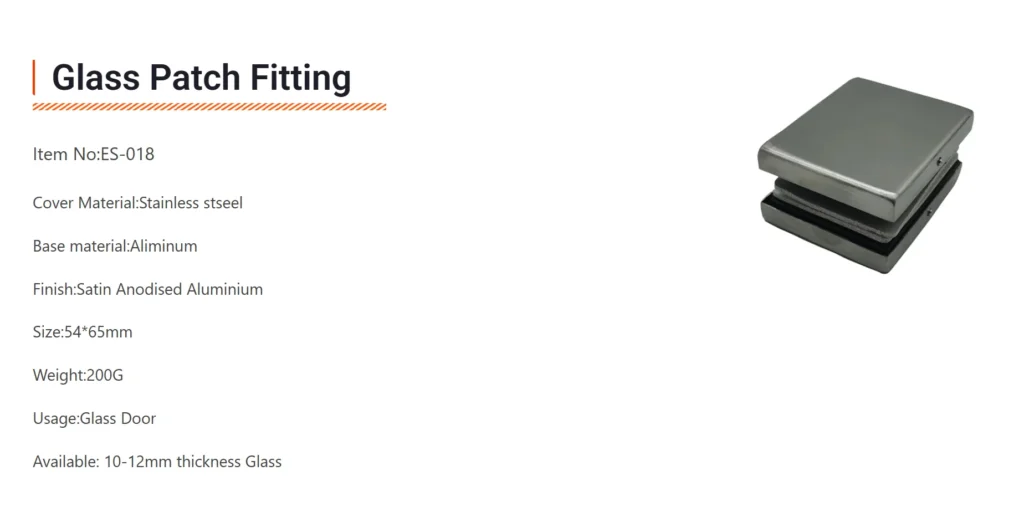
While D-shaped clamps are dominant, square and round clamps offer alternatives for different aesthetics and installation needs.
Square glass clamps deliver a more geometric, industrial look, ideal for office partitions or minimalist interiors.
Round glass clamps create a softer, more continuous visual flow — often used for curved railings or boutique shops.
Common materials: stainless steel (304/316), brass, or zinc alloy.
Surface finishes: mirror, satin, matte black, or gold.
Applications:
• Office glass walls and partitions • Balconies and stair balustrades • Commercial entrances
Advantages:
• Variety of designs to match any architectural style.
• Compatible with 8–12 mm glass panels.
• Easy replacement and standard mounting dimensions.
Pro tip:
For export, offer mixed-size sets (e.g., 45 mm and 63 mm square clamps) to suit both European and Asian building standards.
3. Shower Door Glass Clamps
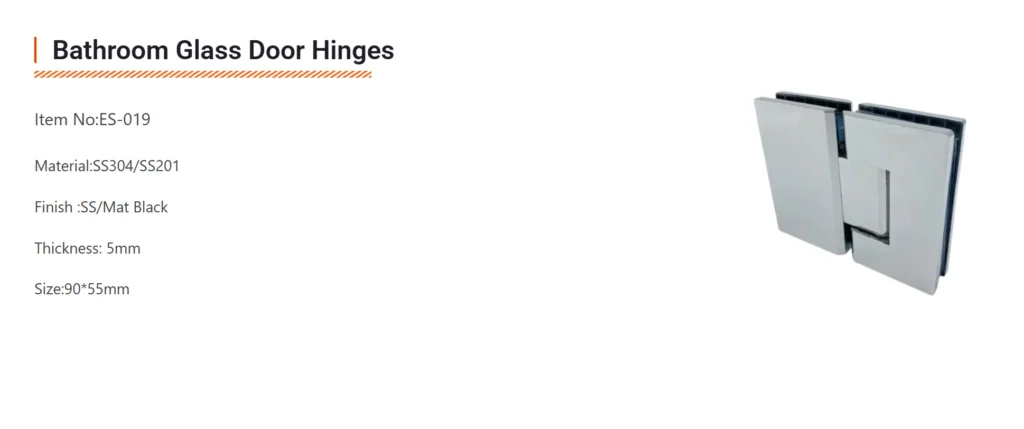
Shower glass clamps are designed specifically for wet environments, where corrosion resistance is critical.
Material: usually stainless steel 304 or brass with chrome plating.
Finish: mirror polish to resist water spots and rust.
Glass thickness: 6–10 mm.
Common types:
• Corner clamps (for 90° joins) • Wall-to-glass clamps • Floor-mounted or ceiling-mounted clamps
Advantages:
• Compact and decorative. • Anti-corrosion and easy to clean. • Provide stability for frameless shower enclosures.
For importers:
This type of clamp sells steadily in renovation and construction markets — a small but high-turnover product line.
4. Aluminum Long Glass Clamps for Sliding Doors
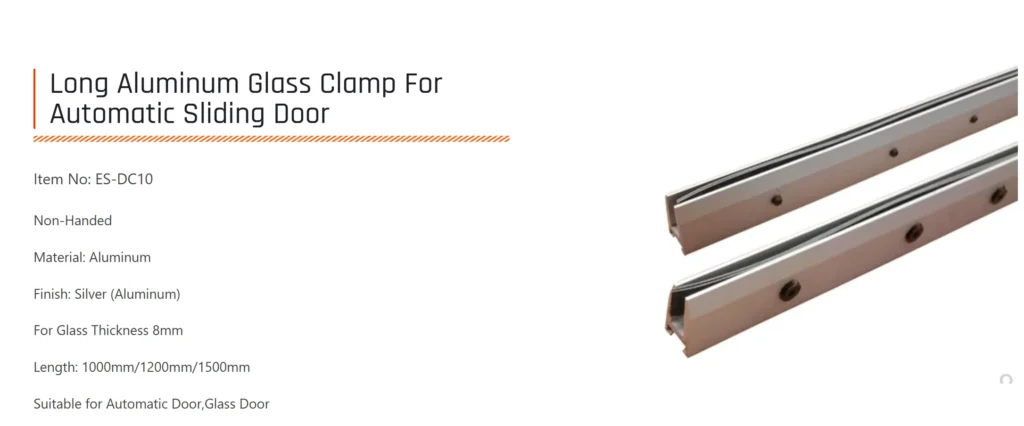
Aluminum long glass clamps are used to hold sliding glass door panels securely while allowing smooth movement.
Key features:
• Lightweight but strong aluminum alloy. • Long-body design to distribute pressure evenly. • Compatible with 8–12 mm glass. • Often anodized for durability and a sleek look.
Applications:
• Residential and office sliding glass doors. • Glass partitions in hotels and shopping malls.
Advantages:
• Economical alternative to stainless steel. • Easy installation — ideal for mass projects. • Excellent corrosion resistance with anodized coating.
Wholesaler insight:
These clamps are especially popular in Southeast Asia and the Middle East due to their balance of strength and cost efficiency.
5.Decorative or Custom Glass Clamps
Modern design trends increasingly favor decorative and concealed glass clamps. These can include colored PVD coatings, minimal corner clamps, or custom-logo versions for branding projects.
Applications:
• Interior décor projects, showrooms, boutique stores. • Frameless glass doors in luxury hotels and villas.
Advantages:
• Aesthetic appeal and unique design flexibility. • Help importers attract premium customers. • Can be customized to match brand or project theme.
How to Choose the Right Glass Clamp?
Selecting the right glass clamp requires balancing design, safety, and cost. For wholesalers and importers, understanding customer needs in various markets is key.
1.Choose Based on Application
| Application | Recommended Clamp Type | Material |
| Front glass door / storefront | D-shaped clamp | Stainless steel 304/316 |
| Shower enclosure | Compact clamp | Stainless steel or brass |
| Sliding glass door | Long clamp | Aluminum |
| Balcony / railing | Square or D-shaped clamp | Stainless steel 316 |
| Office partition | Round or square clamp | Stainless steel or zinc alloy |
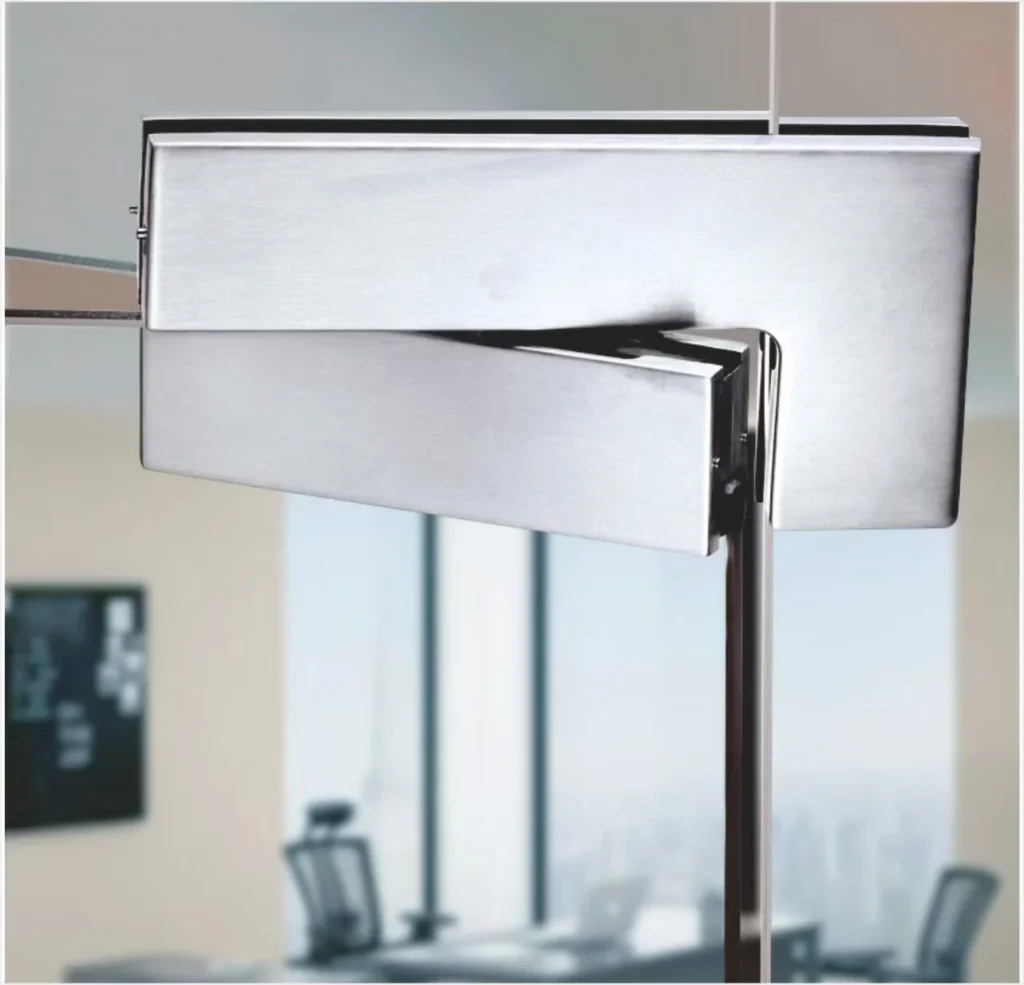
2. Choose Based on Glass Thickness
Always match the clamp’s gasket and body size to your glass thickness.
Typical ranges:
• 6 mm – 8 mm → shower glass or light doors
• 8 mm – 12 mm → commercial glass doors
• 12 mm – 15 mm → railing systems and exterior applications
Incorrect sizing can cause slippage or glass damage. Always verify the manufacturer’s specification before installation.
3.Choose Based on Material
| Material | Features | Ideal Use |
| Stainless Steel 304 | Strong, durable, moderate corrosion resistance | Indoor/outdoor standard use |
| Stainless Steel 316 | Excellent corrosion resistance | Coastal or humid environments |
| Aluminum Alloy | Lightweight, affordable | Sliding doors, interior partitions |
| Zinc Alloy | Cost-effective for interior projects | Temporary or light structures |
For wholesalers, offering multiple materials ensures broader market coverage and flexibility in pricing tiers.
4.Choose Based on Installation Method
1. Screw-Fixed Glass Clamp:
Common and simple. Ideal for frameless glass doors, railings, and partitions.
2. Weldable Clamps:
Suitable for heavy-duty or permanent installations. Typically used in commercial railings
3. Friction-Fit or Clip-On Clamps:
Fast installation without drilling the frame. Great for renovation markets.
5.Choose Based on Market Trends
Different regions have different preferences:
• Europe: Satin finish, 316-grade stainless steel, minimalist square design.
• Middle East: Mirror finish, heavier clamps for large glass panels.
• Asia-Pacific: Aluminum long clamps and cost-efficient zinc alloy types.
If you’re an importer, analyze the architectural style and climatic conditions of your target market before ordering in bulk.
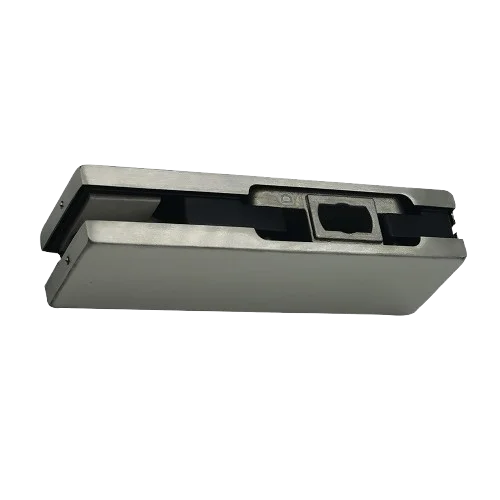
Common Mistakes When Using Glass Clamps
Even the best clamp won’t perform well if installed incorrectly. Here are typical mistakes to avoid:
1. Over-tightening screws – can cause glass cracking or stress marks.
2. Using wrong gasket thickness – leads to loose glass or slipping.
3. Installing indoor clamps outdoors – causes premature rust.
4. Mixing materials – using non-matching metals can cause galvanic corrosion.
5. Ignoring local safety codes – especially in balustrade or public building installations.
For wholesalers, providing proper installation guidance to your customers can help reduce warranty claims and increase brand trust.
Maintenance and Quality Control Tips
To maintain appearance and safety, glass clamps should be cleaned and checked regularly — especially in humid or coastal areas.
Maintenance tips for end users:
• Wipe with a soft cloth and mild detergent. • Avoid abrasive cleaners or steel wool. • Inspect rubber gaskets annually for cracks or hardening. • Replace damaged clamps immediately.
Quality control tips for importers:
• Inspect each shipment for surface scratches or uneven polishing. • Ensure screw threads are smooth and well-lubricated. • Check for consistent gasket materials and sizes. • Keep clamps stored in dry conditions to prevent tarnishing during transit.
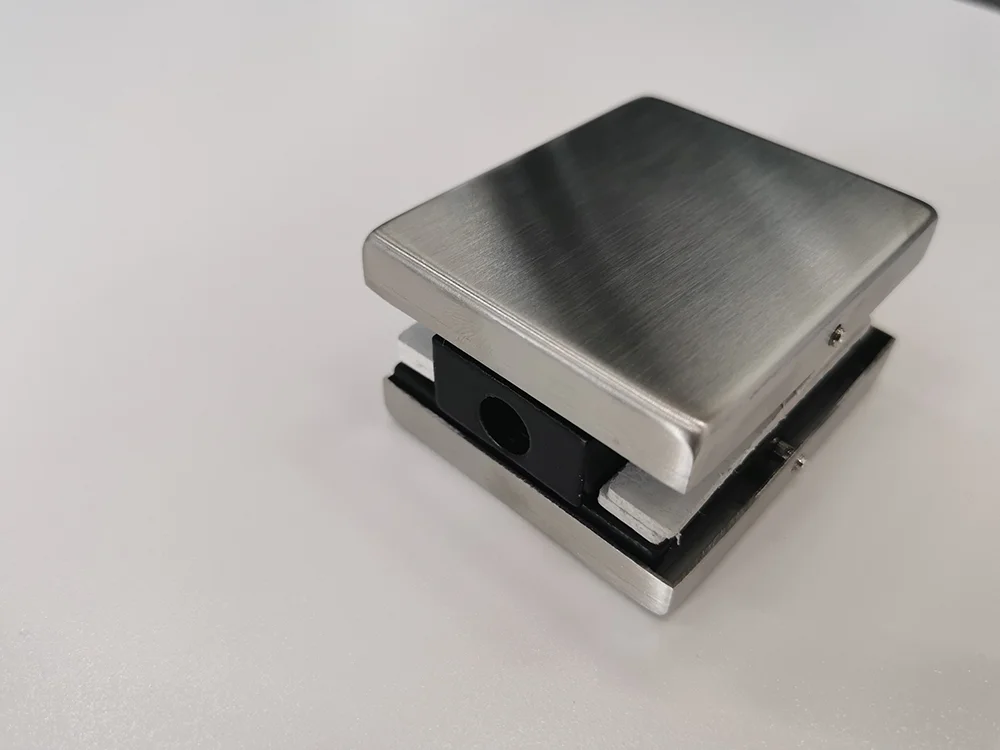
Frequently Asked Questions
1.What is the use of glass clamp?
A glass clamp is a tool to securely hold, stabilize, or position glass components (e.g., lab glassware, glass panels, shelves, or tubes) across scenarios. Its key uses:
- Labs: Fix beakers/flasks to stands for safe experiments.
- Architecture: Install glass partitions, shelves, or railings.
- Industry: Handle glass during manufacturing/transport.
- Displays: Hold glass backdrops/signage in studios/exhibitions.
It prevents glass slipping/breaking while ensuring safety and precision.
2.What are the common materials for glass clamps?
Glass clamps use different materials based on their application (e.g., lab safety, outdoor use, or scratch prevention). Common materials include:
- Stainless Steel: Most widely used—corrosion-resistant (for labs/Outdoor railings), strong (supports heavy glass like shelves/railings), and durable.
- Aluminum Alloy: Lightweight yet sturdy, ideal for indoor glass (e.g., partitions, display clamps) and reduces installation weight.
- Plastic (e.g., ABS, Nylon): Low-cost, non-scratching (safe for thin/decorative glass), and used for lightweight needs (e.g., lab test tube clamps, small display clamps).
- Rubber/Silicone/Foam (Lining): Not the main body, but a key accessory—lines clamp jaws to prevent glass scratches and boost grip (used in all types, from labs to shelves).
- Brass: For high-end or decorative clamps (e.g., luxury interior glass shelves)—corrosion-resistant and has an elegant finish.
3.Can glass clamps be used in outdoor environments?
Yes, but only specialized glass clamps designed for outdoor use—standard indoor clamps may fail due to weather or environmental stress.
Key factors for outdoor suitability:
- Corrosion-resistant materials: Most use stainless steel (prevents rust from rain/humidity) or powder-coated aluminum (adds weather protection).
- Weatherproof components: Jaws may have UV-resistant rubber/silicone linings (to avoid cracking from sun exposure) instead of regular foam.
Common outdoor uses: Securing glass railings (balconies/decks), outdoor glass partitions, or garden display glass.
Conclusion
Glass clamps may look small, but they play a huge role in modern architecture — ensuring safety, functionality, and aesthetics. Understanding the different types of glass clamps, from D-shaped stainless steel models to long aluminum clamps for sliding doors, helps wholesalers and importers select the right products for each market.
Choosing a high-quality, properly sized clamp not only prevents costly installation problems but also enhances the lifespan and appearance of every glass door project.
If you’re looking for stainless steel and aluminum glass clamps, we’re here to help.
👉 Contact us today to learn more about our complete range of glass clamps, competitive wholesale prices, and OEM customization options for your market.